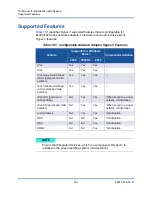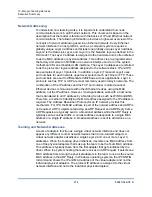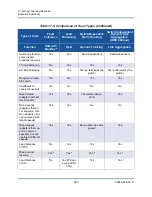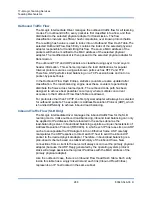
17–QLogic Teaming Services
Executive Summary
274
83840-546-00 D
Network Addressing
To understand how teaming works, it is important to understand how node
communications work in an Ethernet network. This document is based on the
assumption that the reader is familiar with the basics of IP and Ethernet network
communications. The following information provides a high-level overview of the
concepts of network addressing used in an Ethernet network. Every Ethernet
network interface in a host platform, such as a computer system, requires a
globally unique Layer 2 address and at least one globally unique Layer 3 address.
Layer 2 is the Data Link Layer, and Layer 3 is the Network layer as defined in the
OSI model. The Layer 2 address is assigned to the hardware and is often referred
to as the MAC address or physical address. This address is pre-programmed at
the factory and stored in NVRAM on a network interface card or on the system
motherboard for an embedded LAN interface. The Layer 3 addresses are referred
to as the protocol or logical address assigned to the software stack. IP and IPX
are examples of Layer 3 protocols. In addition, Layer 4 (Transport Layer) uses
port numbers for each network upper level protocol such as Telnet or FTP. These
port numbers are used to differentiate traffic flows across applications. Layer 4
protocols such as TCP or UDP are most commonly used in today’s networks. The
combination of the IP address and the TCP port number is called a socket.
Ethernet devices communicate with other Ethernet devices using the MAC
address, not the IP address. However, most applications work with a host name
that is translated to an IP address by a Naming Service such as WINS and DNS.
Therefore, a method of identifying the MAC address assigned to the IP address is
required. The Address Resolution Protocol for an IP network provides this
mechanism. For IPX, the MAC address is part of the network address and ARP is
not required. ARP is implemented using an ARP Request and ARP Reply frame.
ARP Requests are typically sent to a broadcast address while the ARP Reply is
typically sent as unicast traffic. A unicast address corresponds to a single MAC
address or a single IP address. A broadcast address is sent to all devices on a
network.
Teaming and Network Addresses
A team of adapters function as a single virtual network interface and does not
appear any different to other network devices than a non-teamed adapter. A
virtual network adapter advertises a single Layer 2 and one or more Layer 3
addresses. When the teaming driver initializes, it selects one MAC address from
one of the physical adapters that make up the team to be the Team MAC address.
This address is typically taken from the first adapter that gets initialized by the
driver. When the system hosting the team receives an ARP request, it selects one
MAC address from among the physical adapters in the team to use as the source
MAC address in the ARP Reply. In Windows operating systems, the IPCONFIG
/all command shows the IP and MAC address of the virtual adapter and not the
individual physical adapters. The protocol IP address is assigned to the virtual
network interface and not to the individual physical adapters.
















































